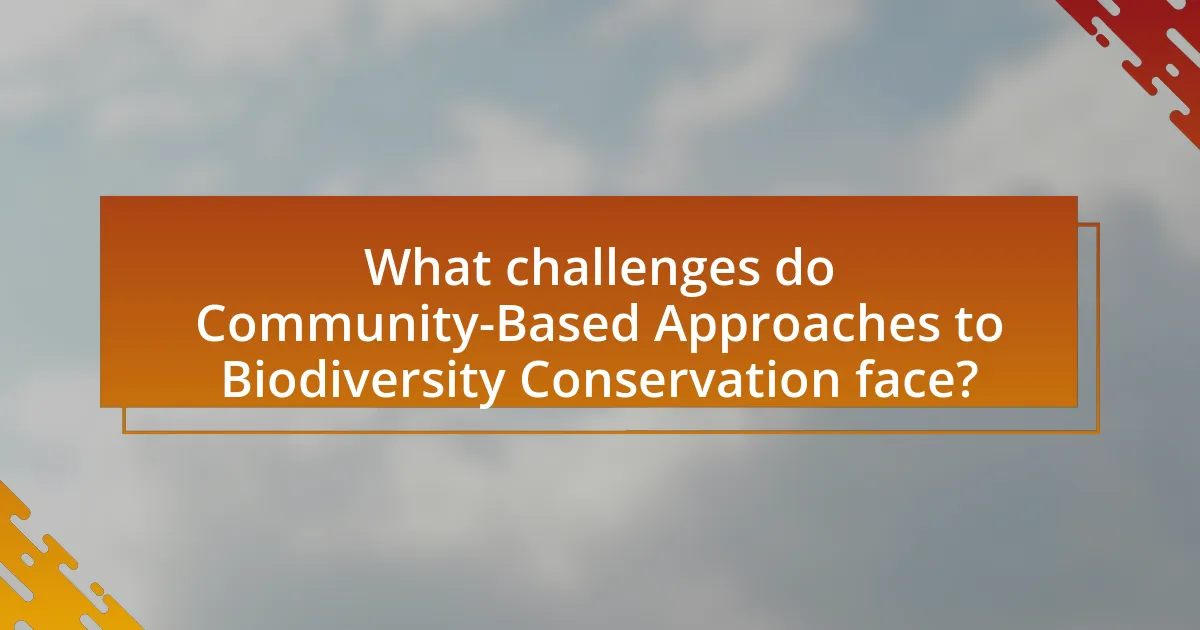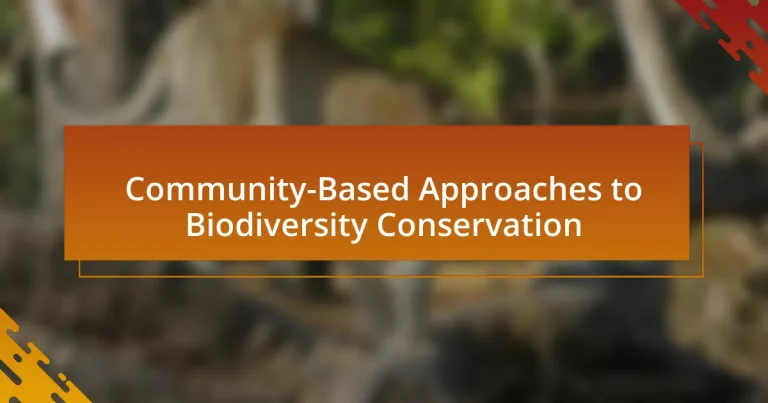Community-Based Approaches to Biodiversity Conservation emphasize the active involvement of local communities in managing and protecting their natural resources. These approaches leverage local knowledge and practices, leading to enhanced biodiversity outcomes compared to traditional top-down conservation methods. Key principles include local participation, sustainable resource management, and the integration of traditional knowledge, all aimed at empowering communities while aligning conservation efforts with their cultural values and economic needs. The article also addresses the benefits of community engagement, the challenges faced in implementation, and best practices for fostering effective conservation initiatives.

What are Community-Based Approaches to Biodiversity Conservation?
Community-based approaches to biodiversity conservation involve the active participation of local communities in the management and protection of their natural resources. These approaches recognize that local knowledge, practices, and stewardship are crucial for effective conservation efforts. For instance, studies have shown that areas managed by local communities often exhibit higher biodiversity levels compared to those under strict government control, as local stakeholders are more invested in the sustainability of their environment. This participatory model not only enhances conservation outcomes but also supports the livelihoods and cultural values of the communities involved.
How do these approaches differ from traditional conservation methods?
Community-based approaches to biodiversity conservation differ from traditional conservation methods by emphasizing local community involvement and stewardship in the management of natural resources. Traditional conservation often relies on top-down strategies, where decisions are made by external authorities without local input, potentially leading to conflicts and ineffective outcomes. In contrast, community-based approaches prioritize the knowledge, needs, and rights of local populations, fostering collaboration and sustainable practices that align with cultural values. Evidence shows that involving communities can enhance conservation effectiveness; for instance, a study published in the journal “Conservation Biology” found that areas managed by local communities often exhibit higher biodiversity levels compared to those governed by external entities.
What are the key principles of community-based conservation?
The key principles of community-based conservation include local participation, sustainable resource management, and the integration of traditional knowledge. Local participation ensures that community members are actively involved in decision-making processes, which fosters a sense of ownership and responsibility towards conservation efforts. Sustainable resource management emphasizes the need to balance ecological health with community livelihoods, ensuring that natural resources are used in a way that meets present needs without compromising future generations. The integration of traditional knowledge recognizes the value of indigenous practices and cultural insights in managing biodiversity, which can enhance the effectiveness of conservation strategies. These principles are supported by various case studies demonstrating successful community-led initiatives that have led to improved biodiversity outcomes while benefiting local communities.
Why is community involvement crucial in biodiversity conservation?
Community involvement is crucial in biodiversity conservation because it fosters local stewardship and enhances the effectiveness of conservation efforts. Engaging communities ensures that conservation strategies are culturally relevant and tailored to local needs, which increases compliance and participation. Research indicates that areas with strong community engagement in conservation initiatives, such as the Ngorongoro Conservation Area in Tanzania, have seen improved biodiversity outcomes and sustainable resource management. This local involvement leads to better monitoring of ecosystems and wildlife, as community members often possess valuable traditional knowledge and a vested interest in the health of their environment.
What are the main goals of community-based biodiversity conservation?
The main goals of community-based biodiversity conservation are to enhance local stewardship of natural resources, promote sustainable livelihoods, and ensure the protection of biodiversity through community engagement. These goals aim to empower local communities to manage their ecosystems effectively, recognizing their traditional knowledge and practices. Research indicates that when communities are actively involved in conservation efforts, such as through the establishment of community-managed protected areas, biodiversity outcomes improve significantly. For instance, a study published in “Conservation Biology” by Berkes (2007) highlights that community-based approaches can lead to better conservation results compared to top-down management strategies, as they align conservation efforts with local needs and priorities.
How do these goals align with global biodiversity targets?
Community-based approaches to biodiversity conservation align with global biodiversity targets by promoting local stewardship and sustainable practices that directly contribute to the preservation of ecosystems. These approaches empower communities to manage natural resources, which is essential for achieving targets set by international agreements such as the Convention on Biological Diversity (CBD). For instance, the Aichi Biodiversity Targets emphasize the importance of engaging local communities in conservation efforts, recognizing that local knowledge and practices can enhance biodiversity outcomes. Evidence shows that areas managed by local communities often exhibit higher biodiversity levels compared to those under centralized management, demonstrating the effectiveness of these approaches in meeting global biodiversity goals.
What role does sustainable development play in these goals?
Sustainable development is essential for achieving community-based biodiversity conservation goals as it integrates ecological health, economic viability, and social equity. This approach ensures that conservation efforts are not only environmentally sound but also economically feasible and socially acceptable, fostering community engagement and ownership. For instance, the United Nations’ Sustainable Development Goals emphasize the importance of protecting ecosystems while promoting sustainable livelihoods, demonstrating that sustainable development directly supports biodiversity conservation by aligning conservation objectives with community needs and aspirations.

What are the benefits of Community-Based Approaches to Biodiversity Conservation?
Community-Based Approaches to Biodiversity Conservation enhance local engagement and stewardship, leading to more effective conservation outcomes. These approaches empower communities to manage their natural resources, fostering a sense of ownership and responsibility. Research indicates that when local populations are involved, conservation efforts are more likely to succeed; for example, a study published in the journal “Conservation Biology” found that community-managed areas often have higher biodiversity levels compared to those managed by external entities. Additionally, these approaches can improve livelihoods by integrating conservation with sustainable development, as seen in various projects where local communities benefit economically from preserving their ecosystems.
How do these approaches enhance local livelihoods?
Community-based approaches to biodiversity conservation enhance local livelihoods by promoting sustainable resource management and empowering local communities. These approaches often involve the participation of local populations in decision-making processes, which leads to better stewardship of natural resources. For instance, when communities are involved in conservation efforts, they can develop eco-tourism initiatives that generate income while preserving biodiversity. Research indicates that areas with community-managed resources often see improved economic outcomes; for example, a study by the World Resources Institute found that community-managed forests in Nepal increased household incomes by up to 30%. This direct involvement not only provides financial benefits but also fosters a sense of ownership and responsibility towards local ecosystems, ultimately leading to enhanced resilience and sustainability of livelihoods.
What economic opportunities arise from community-based conservation?
Community-based conservation creates economic opportunities through sustainable tourism, job creation, and resource management. Sustainable tourism allows local communities to generate income by attracting visitors interested in wildlife and natural landscapes, which can lead to increased funding for conservation efforts. Job creation occurs as communities engage in conservation activities, such as guiding tours or managing protected areas, which can provide stable employment and enhance local economies. Additionally, effective resource management ensures that communities can sustainably harvest natural resources, leading to long-term economic benefits while preserving biodiversity. Studies have shown that regions implementing community-based conservation strategies often experience improved economic resilience and enhanced livelihoods for local populations.
How does community engagement improve conservation outcomes?
Community engagement improves conservation outcomes by fostering local stewardship and enhancing the effectiveness of conservation initiatives. When communities are actively involved in conservation efforts, they are more likely to understand the importance of biodiversity and take ownership of local resources. Research shows that areas with strong community involvement, such as the Ngorongoro Conservation Area in Tanzania, have seen increased wildlife populations and improved habitat conditions due to local management practices. Additionally, studies indicate that community-led conservation projects can lead to better compliance with regulations and sustainable practices, as local stakeholders are more invested in the success of these initiatives.
What social benefits are associated with community-based conservation?
Community-based conservation provides several social benefits, including enhanced community cohesion, improved livelihoods, and increased environmental awareness. By involving local communities in conservation efforts, these initiatives foster a sense of ownership and responsibility towards natural resources, which strengthens social ties and collaboration among community members. For instance, studies have shown that when communities actively participate in conservation, they often experience economic benefits through sustainable practices, such as ecotourism or sustainable harvesting, which can lead to improved quality of life. Additionally, community-based conservation initiatives often include educational components that raise awareness about biodiversity and environmental stewardship, further empowering individuals and communities to engage in sustainable practices.
How does community-based conservation foster social cohesion?
Community-based conservation fosters social cohesion by actively involving local communities in the management and protection of natural resources. This participatory approach encourages collaboration among community members, leading to strengthened relationships and shared goals. For instance, when communities collectively engage in conservation efforts, they develop a sense of ownership and responsibility towards their environment, which enhances trust and cooperation. Research indicates that communities involved in conservation initiatives report higher levels of social capital, as seen in studies conducted in regions like the Amazon, where local stewardship has led to improved social ties and collective action.
What educational opportunities are created through these initiatives?
Community-based approaches to biodiversity conservation create educational opportunities such as workshops, training programs, and community engagement activities. These initiatives often involve local communities in conservation efforts, providing them with knowledge about sustainable practices, ecological awareness, and the importance of biodiversity. For example, programs like the “Community Conservation Learning Network” have demonstrated that involving local populations in conservation not only enhances their understanding of ecological systems but also empowers them to take active roles in preserving their environment. This hands-on learning fosters a deeper connection to local ecosystems and promotes stewardship among community members.

What challenges do Community-Based Approaches to Biodiversity Conservation face?
Community-Based Approaches to Biodiversity Conservation face several challenges, including insufficient funding, lack of local engagement, and conflicts between conservation goals and community needs. Insufficient funding limits the resources available for effective implementation and sustainability of conservation initiatives. Lack of local engagement often results in community members feeling disconnected from conservation efforts, leading to reduced participation and support. Additionally, conflicts arise when conservation goals do not align with the economic or social needs of local communities, which can lead to resistance against conservation measures. These challenges hinder the effectiveness of community-based strategies in achieving biodiversity conservation objectives.
What are the common obstacles to successful implementation?
Common obstacles to successful implementation of community-based approaches to biodiversity conservation include lack of community engagement, insufficient funding, and inadequate training. Lack of community engagement often leads to resistance or apathy towards conservation initiatives, as local stakeholders may not see the benefits or relevance to their lives. Insufficient funding restricts the resources available for projects, limiting their scope and sustainability. Inadequate training can result in poor execution of conservation strategies, as community members may lack the necessary skills or knowledge to effectively manage biodiversity efforts. These obstacles have been documented in various studies, highlighting the importance of addressing them to enhance the effectiveness of conservation initiatives.
How do power dynamics within communities affect conservation efforts?
Power dynamics within communities significantly influence conservation efforts by determining who has decision-making authority and access to resources. When power is concentrated in the hands of a few, marginalized groups may lack representation, leading to conservation strategies that do not reflect the needs or knowledge of the entire community. For instance, research by Agrawal and Gibson (1999) in “Enchantment and Disenchantment: The Role of Community in Resource Management” highlights that inclusive governance structures enhance local participation, resulting in more effective conservation outcomes. Conversely, inequitable power relations can foster conflict and resistance against conservation initiatives, undermining their success.
What external factors can hinder community-based initiatives?
External factors that can hinder community-based initiatives include lack of funding, political instability, and insufficient support from local authorities. Lack of funding restricts resources necessary for project implementation, as seen in various community conservation efforts that fail due to financial constraints. Political instability can disrupt community engagement and project continuity, evidenced by cases where civil unrest has led to the abandonment of local conservation initiatives. Additionally, insufficient support from local authorities can undermine community efforts, as local governance plays a crucial role in facilitating or obstructing initiatives, demonstrated by instances where bureaucratic hurdles have stalled biodiversity projects.
How can these challenges be addressed effectively?
Community-based approaches to biodiversity conservation can effectively address challenges by fostering local engagement and empowering communities to manage their natural resources. Involving local populations in decision-making processes ensures that conservation strategies align with their needs and knowledge, leading to more sustainable practices. For instance, the establishment of community-managed protected areas has shown success in various regions, such as the Ngorongoro Conservation Area in Tanzania, where local stewardship has led to increased wildlife populations and improved livelihoods. Additionally, integrating traditional ecological knowledge with scientific research enhances the effectiveness of conservation efforts, as evidenced by studies demonstrating that indigenous practices often promote biodiversity.
What strategies can enhance community capacity for conservation?
Strategies that can enhance community capacity for conservation include education and awareness programs, participatory resource management, and building partnerships with local organizations. Education and awareness programs empower community members by providing knowledge about biodiversity and conservation practices, which has been shown to increase local engagement in conservation efforts. Participatory resource management involves communities in decision-making processes regarding natural resources, fostering a sense of ownership and responsibility, as evidenced by successful initiatives in various regions where local involvement led to improved conservation outcomes. Building partnerships with local organizations and stakeholders facilitates resource sharing, technical support, and access to funding, which strengthens community initiatives and enhances overall conservation capacity.
How can partnerships with external organizations support local efforts?
Partnerships with external organizations can enhance local efforts by providing access to resources, expertise, and networks that local entities may lack. For instance, external organizations often bring funding opportunities, technical knowledge, and best practices from other regions, which can significantly bolster local biodiversity conservation initiatives. A study by the World Resources Institute highlights that collaborations between local communities and external NGOs have led to improved conservation outcomes, demonstrating that such partnerships can effectively mobilize additional resources and foster knowledge exchange.
What are best practices for implementing Community-Based Approaches to Biodiversity Conservation?
Best practices for implementing Community-Based Approaches to Biodiversity Conservation include engaging local communities in decision-making processes, fostering partnerships between stakeholders, and integrating traditional ecological knowledge with scientific research. Engaging local communities ensures that conservation efforts align with their needs and values, which enhances participation and compliance. For instance, the success of the Community-Based Natural Resource Management (CBNRM) model in Namibia demonstrates that involving communities in managing wildlife resources leads to increased biodiversity and improved livelihoods. Additionally, fostering partnerships among government agencies, NGOs, and local groups can facilitate resource sharing and capacity building, as seen in the collaborative efforts in the Amazon rainforest. Integrating traditional ecological knowledge with scientific research allows for more culturally relevant and effective conservation strategies, as evidenced by the work of Indigenous communities in Canada, which has shown that traditional practices can significantly contribute to biodiversity conservation.
How can communities effectively engage stakeholders in conservation efforts?
Communities can effectively engage stakeholders in conservation efforts by fostering inclusive participation and transparent communication. This approach ensures that diverse perspectives are considered, which enhances stakeholder buy-in and commitment. For instance, the use of community workshops and forums allows stakeholders to voice their concerns and contribute ideas, leading to more tailored conservation strategies. Research indicates that projects involving local communities and stakeholders have a higher success rate, as seen in the case of the Collaborative Forest Management initiative in Nepal, which resulted in improved forest conditions and increased local livelihoods. Engaging stakeholders through education and awareness campaigns also strengthens their connection to conservation goals, as demonstrated by the success of the “Adopt-a-Park” program in the United States, which mobilized community members to take active roles in park stewardship.
What role does monitoring and evaluation play in these approaches?
Monitoring and evaluation play a critical role in community-based approaches to biodiversity conservation by assessing the effectiveness and impact of conservation strategies. These processes enable stakeholders to track progress, identify challenges, and adapt management practices based on empirical data. For instance, regular monitoring can reveal changes in biodiversity indicators, such as species population trends or habitat conditions, which inform decision-making and resource allocation. Evaluation provides insights into the social and ecological outcomes of conservation efforts, ensuring that community engagement and local knowledge are integrated into adaptive management. This evidence-based approach enhances accountability and fosters continuous improvement in biodiversity conservation initiatives.

